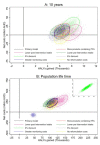Estimated health benefits, costs, and cost-effectiveness of eliminating industrial trans-fatty acids in Australia: A modelling study
- PMID: 33137090
- PMCID: PMC7605626
- DOI: 10.1371/journal.pmed.1003407
Estimated health benefits, costs, and cost-effectiveness of eliminating industrial trans-fatty acids in Australia: A modelling study
Abstract
Background: trans-fatty acids (TFAs) are a well-known risk factor of ischemic heart disease (IHD). In Australia, the highest TFA intake is concentrated to the most socioeconomically disadvantaged groups. Elimination of industrial TFA (iTFA) from the Australian food supply could result in reduced IHD mortality and morbidity while improving health equity. However, such legislation could lead to additional costs for both government and food industry. Thus, we assessed the potential cost-effectiveness, health gains, and effects on health equality of an iTFA ban from the Australian food supply.
Methods and findings: Markov cohort models were used to estimate the impact on IHD burden and health equity, as well as the cost-effectiveness of a national ban of iTFA in Australia. Intake of TFA was assessed using the 2011-2012 Australian National Nutrition and Physical Activity Survey. The IHD burden attributable to TFA was calculated by comparing the current level of TFA intake to a counterfactual setting where consumption was lowered to a theoretical minimum distribution with a mean of 0.5% energy per day (corresponding to TFA intake only from nonindustrial sources, e.g., dairy foods). Policy costs, avoided IHD events and deaths, health-adjusted life years (HALYs) gained, and changes in IHD-related healthcare costs saved were estimated over 10 years and lifetime of the adult Australian population. Cost-effectiveness was assessed by calculation of incremental cost-effectiveness ratios (ICERs) using net policy cost and HALYs gained. Health benefits and healthcare cost changes were also assessed in subgroups based on socioeconomic status, defined by Socio-Economic Indexes for Areas (SEIFA) quintile, and remoteness. Compared to a base case of no ban and current TFA intakes, elimination of iTFA was estimated to prevent 2,294 (95% uncertainty interval [UI]: 1,765; 2,851) IHD deaths and 9,931 (95% UI: 8,429; 11,532) IHD events over the first 10 years. The greatest health benefits were accrued to the most socioeconomically disadvantaged quintiles and among Australians living outside of major cities. The intervention was estimated to be cost saving (net cost <0 AUD) or cost-effective (i.e., ICER < AUD 169,361/HALY) regardless of the time horizon, with ICERs of 1,073 (95% UI: dominant; 3,503) and 1,956 (95% UI: 1,010; 2,750) AUD/HALY over 10 years and lifetime, respectively. Findings were robust across several sensitivity analyses. Key limitations of the study include the lack of recent data of TFA intake and the small sample sizes used to estimate intakes in subgroups. As with all simulation models, our study does not prove that a ban of iTFA will prevent IHD, rather, it provides the best quantitative estimates and corresponding uncertainty of a potential effect in the absence of stronger direct evidence.
Conclusions: Our model estimates that a ban of iTFAs could avert substantial numbers of IHD events and deaths in Australia and would likely be a highly cost-effective strategy to reduce social-economic and urban-rural inequalities in health. These findings suggest that elimination of iTFA can cost-effectively improve health and health equality even in countries with low iTFA intake.
Conflict of interest statement
The authors have declared that no competing interests exist.
Figures





Similar articles
-
Estimated health benefits, costs and cost-effectiveness of eliminating dietary industrial trans fatty acids in Kenya: cost-effectiveness analysis.BMJ Glob Health. 2023 Oct;8(10):e012692. doi: 10.1136/bmjgh-2023-012692. BMJ Glob Health. 2023. PMID: 37848268 Free PMC article.
-
Estimated health benefits, costs and cost-effectiveness of eliminating industrial trans-fatty acids in Nigeria: cost-effectiveness analysis.BMJ Glob Health. 2024 Apr 17;9(4):e014294. doi: 10.1136/bmjgh-2023-014294. BMJ Glob Health. 2024. PMID: 38631705 Free PMC article.
-
Cost-effectiveness analysis of eliminating industrial and all trans fats in England and Wales: modelling study.J Public Health (Oxf). 2017 Sep 1;39(3):574-582. doi: 10.1093/pubmed/fdw095. J Public Health (Oxf). 2017. PMID: 27613767
-
A trans world journey.Atheroscler Suppl. 2006 May;7(2):47-52. doi: 10.1016/j.atherosclerosissup.2006.04.011. Epub 2006 May 19. Atheroscler Suppl. 2006. PMID: 16713385 Review.
-
Estimation and Prediction of Avoidable Health Care Costs of Cardiovascular Diseases and Type 2 Diabetes Through Adequate Dairy Food Consumption: A Systematic Review and Micro Simulation Modeling Study.Arch Iran Med. 2018 May 1;21(5):213-222. Arch Iran Med. 2018. PMID: 29738265
Cited by
-
Projecting cardiovascular deaths averted due to trans fat policies in the Eurasian Economic Union.Public Health Nutr. 2023 Dec;26(S1):s41-s50. doi: 10.1017/S1368980022001872. Epub 2022 Oct 5. Public Health Nutr. 2023. PMID: 36184895 Free PMC article.
-
Trans Fat Free by 2023-A Building Block of the COVID-19 Response.Front Nutr. 2021 Mar 24;8:645750. doi: 10.3389/fnut.2021.645750. eCollection 2021. Front Nutr. 2021. PMID: 33859993 Free PMC article.
-
Estimated health benefits, costs and cost-effectiveness of eliminating dietary industrial trans fatty acids in Kenya: cost-effectiveness analysis.BMJ Glob Health. 2023 Oct;8(10):e012692. doi: 10.1136/bmjgh-2023-012692. BMJ Glob Health. 2023. PMID: 37848268 Free PMC article.
-
Presence of trans-Fatty Acids Containing Ingredients in Pre-Packaged Foods and the Availability of Reported trans-Fat Levels in Kenya and Nigeria.Nutrients. 2023 Feb 2;15(3):761. doi: 10.3390/nu15030761. Nutrients. 2023. PMID: 36771466 Free PMC article.
-
[Trans fatty acids in nutrition labeling and ingredient listing of prepackaged products in Costa Rica, 2022Ácidos graxos trans na rotulagem nutricional e na lista de ingredientes de produtos pré-embalados na Costa Rica, 2022].Rev Panam Salud Publica. 2025 Aug 1;49:e72. doi: 10.26633/RPSP.2025.72. eCollection 2025. Rev Panam Salud Publica. 2025. PMID: 40755517 Free PMC article. Spanish.
References
-
- Australian Bureau of Statistics. Causes of Death, Australia, 2016, cat. no. 3303.0 2017 [updated 7 February 2018; cited 2018 February 13]. Available from: http://www.abs.gov.au/ausstats/abs@.nsf/0/47E19CA15036B04BCA257757001466....
-
- Uauy R, Aro A, Clarke R, Ghafoorunissa, L'Abbé MR, Mozaffarian D, et al. WHO Scientific Update on trans fatty acids: summary and conclusions. Eur J Clin Nutr. 2009;63:S68 10.1038/ejcn.2009.15 - DOI
Publication types
MeSH terms
Substances
LinkOut - more resources
Full Text Sources
Research Materials

